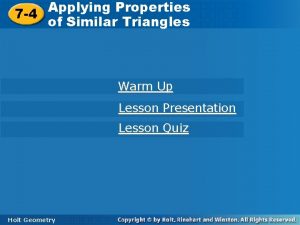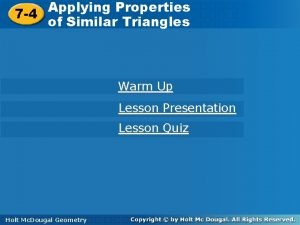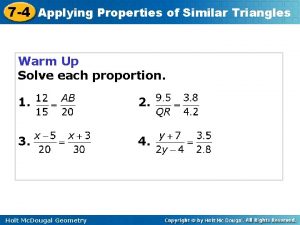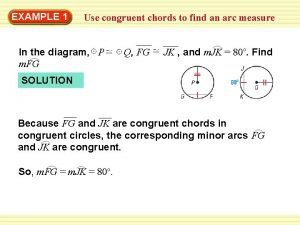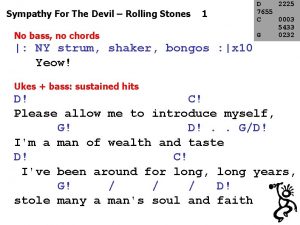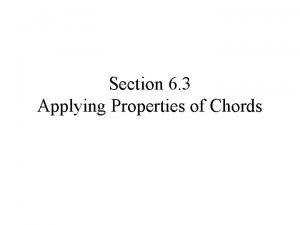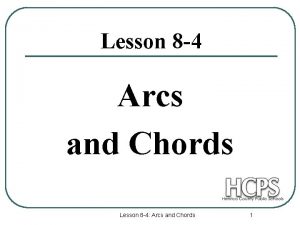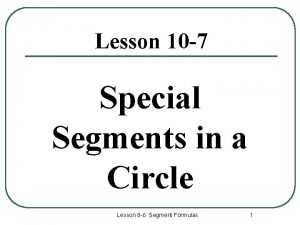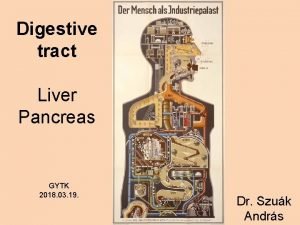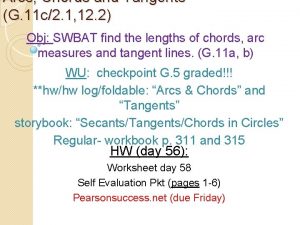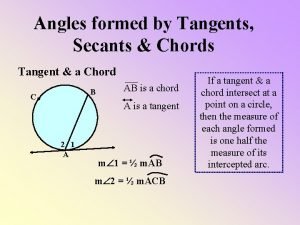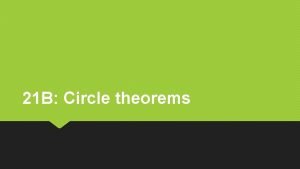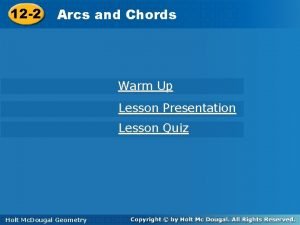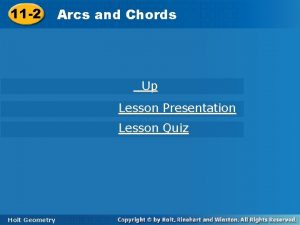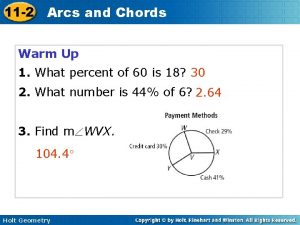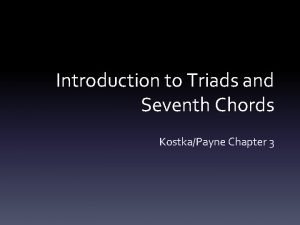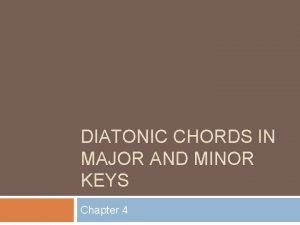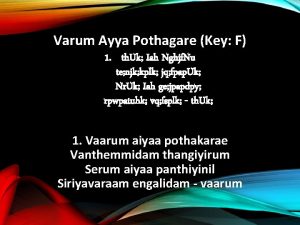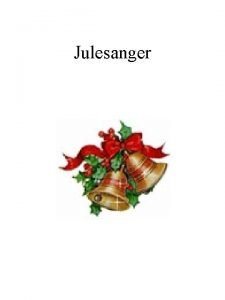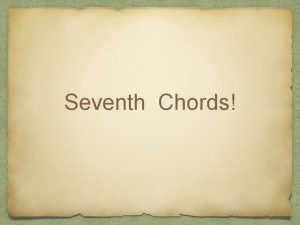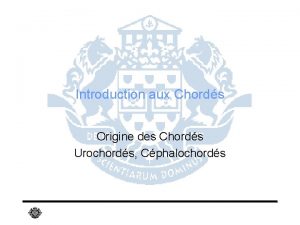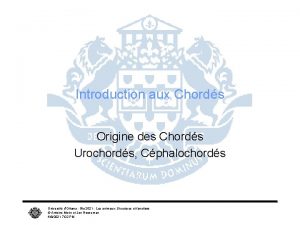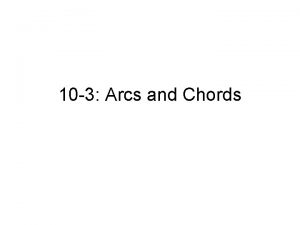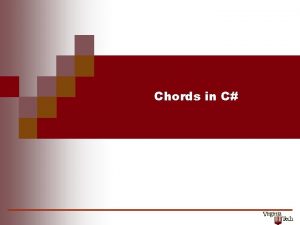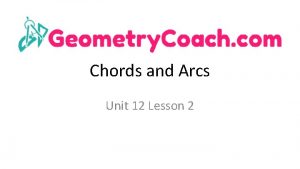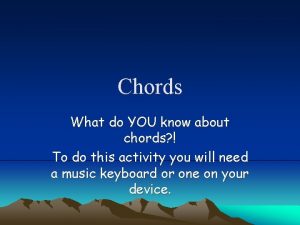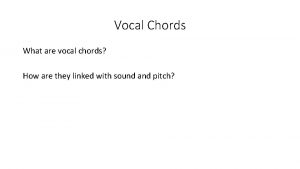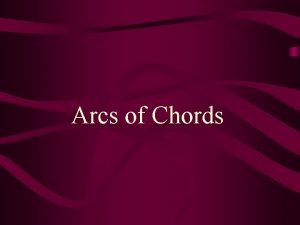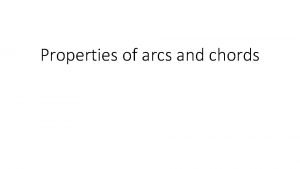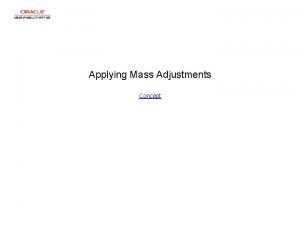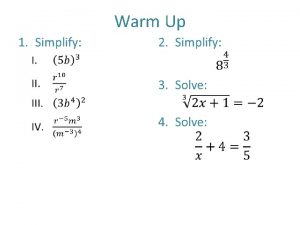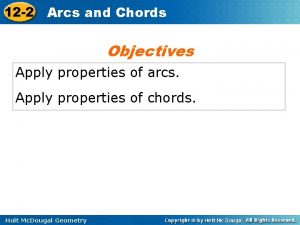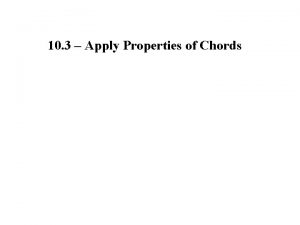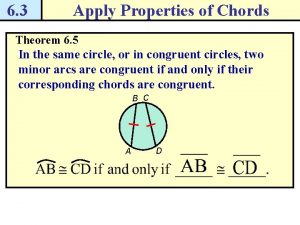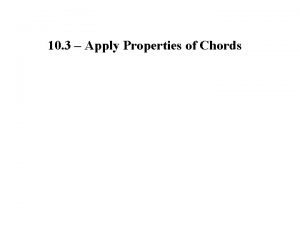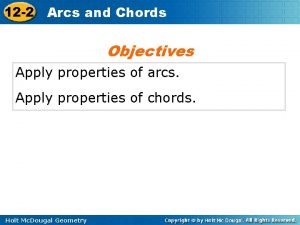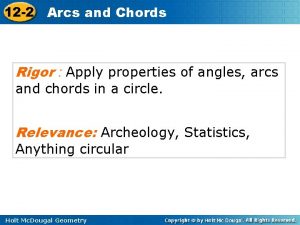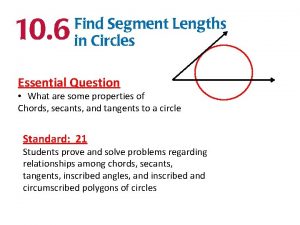Section 6 3 Applying Properties of Chords Warm




























- Slides: 28

Section 6. 3 Applying Properties of Chords

Warm up for Lesson 6. 3 Tell whether the segment is best described as a radius, chord, or diameter of C. 1. DC ANSWER radius

Warm up for Lesson 6. 3 Tell whether the segment is best described as a radius, chord, or diameter of C. 2. BD ANSWER diameter

Warm up for Lesson 6. 3 Tell whether the segment is best described as a radius, chord, or diameter of C. 3. DE ANSWER chord

Warm up for Lesson 6. 3 Tell whether the segment is best described as a radius, chord, or diameter of C. 4. AE ANSWER chord

Theorem 6. 5


Theorem 6. 6

Theorem 6. 7

Theorem 6. 8

EXAMPLE 1 Use congruent chords to find an arc measure In the diagram, P m. FG Q, FG JK , and m. JK = 80 o. Find SOLUTION Because FG and JK are congruent chords in congruent circles, the corresponding minor arcs FG and JK are congruent. So, m. FG = m. JK = 80 o.

GUIDED PRACTICE Use the diagram of for Example 1 D. 1. If m. AB = 110°, find m. BC ANSWER m. BC = 110°

GUIDED PRACTICE Use the diagram of for Example 1 D. 2. If m. AC = 150°, find m. AB ANSWER m. AB = 105°

EXAMPLE 2 Use perpendicular bisectors Gardening Three bushes are arranged in a garden as shown. Where should you place a sprinkler so that it is the same distance from each bush? SOLUTION STEP 1 Label the bushes A, B, and C, as shown. Draw segments AB and BC.

EXAMPLE 2 Use perpendicular bisectors STEP 2 Draw the perpendicular bisectors of AB and BC By Theorem 10. 4, these are diameters of the circle containing A, B, and C. STEP 3 Find the point where these bisectors intersect. This is the center of the circle through A, B, and C, and so it is equidistant from each point.

EXAMPLE 3 Use a diameter Use the diagram of E to find the length of AC. Tell what theorem you use. ANSWER Diameter BD is perpendicular to AC. So, by Theorem 10. 5, BD bisects AC , and CF = AF. Therefore, AC = 2 AF = 2(7) = 14.

GUIDED PRACTICE for Examples 2 and 3 Find the measure of the indicated arc in the diagram. 3. CD ANSWER m. CD = 72°

GUIDED PRACTICE for Examples 2 and 3 Find the measure of the indicated arc in the diagram. 4. DE ANSWER m. CD = m. DE = 72° 5. CE ANSWER m. CE = m. DE + m. CD m. CE = 72° + 72° = 144°

EXAMPLE 4 Use Theorem 6. 8 In the diagram of C, QR = ST = 16. Find CU. SOLUTION Chords QR and ST are congruent, so by Theorem 10. 6 they are equidistant from C. Therefore, CU = CV 2 x = 5 x – 9 x=3 So, CU = 2 x = 2(3) = 6. Use Theorem 6. 8 Substitute. Solve for x.

GUIDED PRACTICE for Example 4 In the diagram in Example 4, suppose ST = 32, and CU = CV = 12. Find the given length. 6. QR ANSWER QR = 32

GUIDED PRACTICE for Example 4 In the diagram in Example 4, suppose ST = 32, and CU = CV = 12. Find the given length. 7. QU ANSWER QU = 16

GUIDED PRACTICE for Example 4 In the diagram in Example 4, suppose ST = 32, and CU = CV = 12. Find the given length. 8. The radius of C ANSWER The radius of C = 20

Daily Homework Quiz For use after Lesson 10. 3 Find the value of x in. C. Explain. 1. ANSWER 6; If a diameter of a circle is to the chord, then the diameter bisects the chord and its arc.

Daily Homework Quiz For use after Lesson 10. 3 Find the value of x in. C. Explain. 2. ANSWER 4; In the same circle, if two chords are equidistant from ~. the center, then they are =

Daily Homework Quiz 3. For use after Lesson 10. 3 Determine whether RS is a diameter. ANSWER Yes. Sample answer: RS is the bisector of TU by Theorem 5. 3. Then RS is a diameter of the circle by Theorem 10. 4.


Homework page 201 1 -13

Homework page 201 1 -13
 7-4 applying properties of similar triangles
7-4 applying properties of similar triangles Applying properties of similar triangles
Applying properties of similar triangles Sas similarity theorem
Sas similarity theorem 7-4 applying properties of similar triangles
7-4 applying properties of similar triangles Congruent chords example
Congruent chords example Sympathy for the devil chords
Sympathy for the devil chords 10-3 practice arcs and chords
10-3 practice arcs and chords 10-3 arcs and chords
10-3 arcs and chords Lesson 8 arcs and chords
Lesson 8 arcs and chords 7.7 special segments in a circle
7.7 special segments in a circle Lesson 10-3 arcs and chords
Lesson 10-3 arcs and chords Chords
Chords Boomwhacker instrument
Boomwhacker instrument 9-3 arcs and chords worksheet answers
9-3 arcs and chords worksheet answers Angles formed by tangents secants and chords
Angles formed by tangents secants and chords 7.4.7 - quick check: angle measures and segment lengths
7.4.7 - quick check: angle measures and segment lengths Intersecting chords theorem
Intersecting chords theorem Quiz 10-2 congruent chords
Quiz 10-2 congruent chords 11-2 arcs and chords
11-2 arcs and chords 11-2 arcs and chords worksheet answers
11-2 arcs and chords worksheet answers Salibonani chords
Salibonani chords Seventh chord inversions
Seventh chord inversions Diatonic chords in major and minor keys
Diatonic chords in major and minor keys Chords rule in dbms
Chords rule in dbms Varum ayya pothagare
Varum ayya pothagare Who sings something's coming in west side story
Who sings something's coming in west side story Brandon blackstock wikipedia
Brandon blackstock wikipedia På låven sitter nissen dansk
På låven sitter nissen dansk Jesus lord my best love thou art lyrics
Jesus lord my best love thou art lyrics
